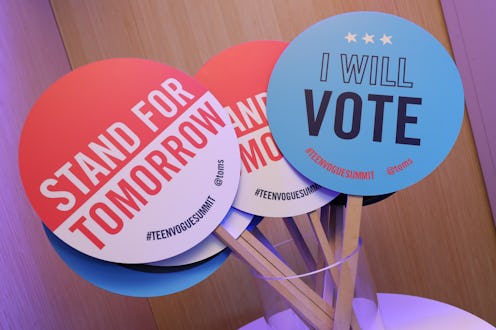News
What To Know About California's Chaotic "Jungle Primary" System As 2018 Midterms Creep Up

As Californians head to the polls in one of the most-watched elections before the 2018 midterms in November, there's a voting system in place that's unfamiliar to most of the country. Typically, political parties vote in a primary for one candidate each to send to the general election. But it's a completely different beast in the California voting booth with candidates vying for the top-two spots in the primary. So, you're probably curious as to how California's top-two primary actually works.
Tuesday's election is an "open, nonpartisan primary," according to The New York Times. This means whoever wins first and second place in an incredibly crowded field of candidates will be the choices on the ballot in November — regardless of party affiliation. There are at least seven Republican congressional seats that stand to be taken by a Democratic candidate since Hillary Clinton carried the districts in the 2016 election. Therefore, the centerpiece of the Democrats regaining control of Congress could rest in this top-two primary system in California.
The New York Times reported that at least three of those seats could see no Democrat on the ticket because there are just too many candidates. PBS New Hour says Southern California districts are the most critical because of the changing voter demographics and parity in party voter registration numbers.
This system doesn't only apply to congressional races, though. It applies to statewide offices, too. In fact, according to The Hill, all eight statewide office positions are up for consideration. The way this primary system is set up — with similar election systems in Louisiana and Washington state — means that there could be two Republicans, two Democrats, one of each party, or a combination including third-party candidates in each race.
The system was put in place in 2010 after 54 percent of voters approved the measure when actor Arnold Schwarzenegger was governor, according to ABC News. "We want to change the dysfunctional political system and we want to get rid of the paralysis and the partisan bickering," Schwarzenegger said at the time of the approval eight years ago. "Those are huge changes that will change everything in the future."
In a statement to The New York Times this week, Schwarzenegger said the system has led to candidates that increased "legislative approval." "All Americans deserve better representation, and California’s reforms have done just that," he said in a statement to the newspaper.
The system has been officially in place since the 2012 election, and the so-called "jungle primary" is not the most favored one among some Golden State politicians. House Democratic leader Nancy Pelosi is facing three Democrats and a Green Party candidate for her San Francisco seat and has called the top-two primary system "terrible," according to ABC News.
A different quirk of the California primary system is how long it takes to count the ballots. As The Los Angeles Times reported over the weekend, the state mostly works with paper ballots after California "decertified" voting machines in 2007 because of privacy concerns. On top of that, there are also just a lot of ballots to count. The newspaper reported that even if only a small amount of California's registered 19 million voters turn out, it could end up being "more ballots than elections officials in 48 states had to count" in November 2016.
The Los Angeles Times goes on to say that at least 70 percent of votes were counted by the weekend in the last two primaries, so it's likely that we're looking at days, not weeks until official results of who will be on the November ballots are released.